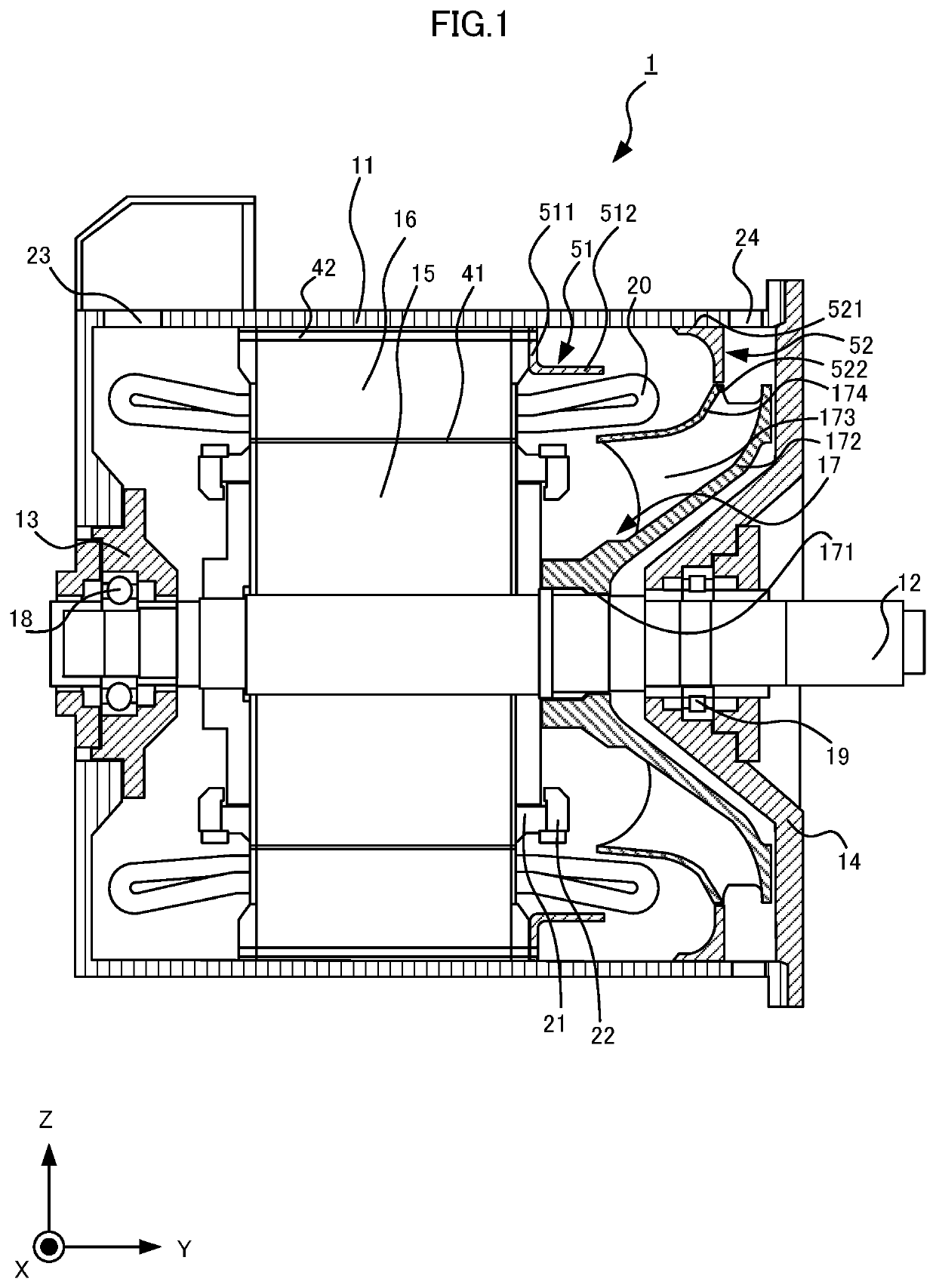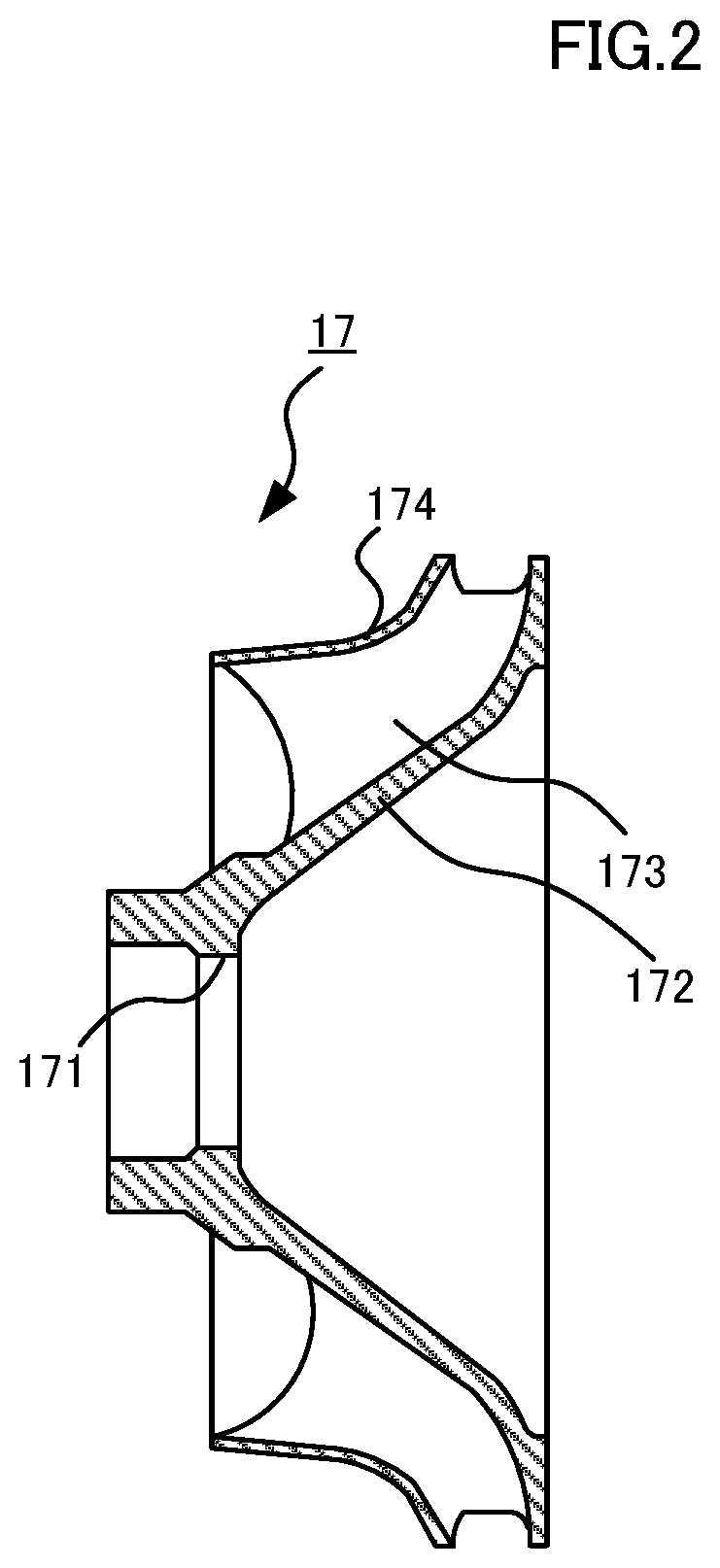Vehicle motor
a technology for vehicles and motors, applied in the direction of locomotives, magnetic circuit rotating parts, magnetic circuit shapes/forms/construction, etc., can solve the problems of increasing internal temperature of the main motor, iron loss, and increasing the temperature of the stator core and the rotor core, so as to increase the internal cooling performance of the vehicle motor
- Summary
- Abstract
- Description
- Claims
- Application Information
AI Technical Summary
Benefits of technology
Problems solved by technology
Method used
Image
Examples
embodiment 1
[0050]FIG. 1 is a cross-sectional view of a vehicle motor according to Embodiment 1 of the present disclosure. FIG. 1 is a cross-sectional view taken along a plane parallel to a rotor shaft 12. A vehicle motor 1 is equipped with: a frame 11 fixed to a vehicle, the rotor shaft 12 contained in the frame 11, a first bracket 13 and a second bracket 14 fixed to the frame 11, a rotor core 15 engaging the rotor shaft 12, a stator core 16 attached to an inner peripheral surface of the frame 11, and a fan 17 attached to the rotor shaft 12. A Z axis is the vertical direction, an X axis is in the direction of travel of the vehicle on which the vehicle motor 1 is mounted, and a Y axis is the direction perpendicular to the X axis and the Z axis. In the case in which the vehicle motor 1 is fixed to a body of the vehicle, for example, an axial direction of the rotor shaft 12 is the X axis direction; and in the case in which the vehicle motor 1 is fixed to a bogie of the vehicle, for example, the a...
embodiment 2
[0068]FIG. 13 is a cross-sectional view of a vehicle motor according to Embodiment 2 of the present disclosure. This drawing is viewed in a manner similar to that of FIG. 1. A vehicle motor 2 according to Embodiment 2 is equipped with a frame 25 in place of the frame 11 provided for the vehicle motor 1. Moreover, the vehicle motor 2 is equipped with a second bracket 26 in place of the second bracket 14 provided for the vehicle motor 1. The vehicle motor 2 is a forced air-cooled type motor and is not equipped with the fan 17. At the first bracket 13 side end portion of the frame 25, a suction port 27 is formed into which flows air exterior to the frame 25. In FIG. 13, the suction port 27 is formed in a vertical direction top side surface of the frame 25. Air sent via a duct from a non-illustrated air blower provided at the exterior flows into the interior of the vehicle motor 2 from the suction port 27. In the vehicle motor 2, an exhaust port 28 is formed in the second bracket 26. Th...
embodiment 3
[0078]FIG. 17 is a cross-sectional view of a vehicle motor according to Embodiment 3 of the present disclosure. This drawing is viewed in a manner similar to that of FIG. 1. In addition to the configuration of the vehicle motor 1 according to Embodiment 1, the vehicle motor 3 according to Embodiment 3 is further equipped with an upwind side air guiding member that suppresses at least a portion of air flowing in from the suction port 23 from arriving directly at the stator ventilating path 42 and that guides at least a portion of the air flowing in from the suction port 23 to the stator ventilating path 42 after contacting the end portion of the stator coil 20. In Embodiment 3, the upwind side air guiding member has a fourth air guiding member 54.
[0079]FIG. 18 is a perspective view of the fourth air guiding member according to Embodiment 3. FIG. 19 is a cross-sectional view of the fourth air guiding member according to Embodiment 3. Shape of a cross section of the fourth air guiding ...
PUM
 Login to View More
Login to View More Abstract
Description
Claims
Application Information
 Login to View More
Login to View More - R&D
- Intellectual Property
- Life Sciences
- Materials
- Tech Scout
- Unparalleled Data Quality
- Higher Quality Content
- 60% Fewer Hallucinations
Browse by: Latest US Patents, China's latest patents, Technical Efficacy Thesaurus, Application Domain, Technology Topic, Popular Technical Reports.
© 2025 PatSnap. All rights reserved.Legal|Privacy policy|Modern Slavery Act Transparency Statement|Sitemap|About US| Contact US: help@patsnap.com



